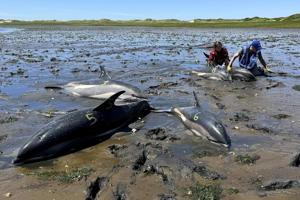The recent stranding of more than 100 dolphins on Cape Cod, the largest such event involving dolphins in U.S. history, is partly due to the peninsula’s geography, with its gently sloping sand flats, tidal fluctuations and proximity to productive feeding grounds, experts said.
The elements, along with the hook-like shape of the cape itself, make Cape Cod a global hotspot for dolphin mass strandings. Rescuers who helped free more than a hundred dolphins from the shoreline last month said Friday that they confirmed that began June 28 was the largest in the U.S.

A final review of data and aerial imagery last week revealed that 146 dolphins were involved in the stranding, according to the International Fund for Animal Welfare. The group estimated that 102 dolphins survived the multiday event. There were 37 natural deaths and seven dolphins had to be euthanized.
Brian Sharp, director of marine mammal rescue for the group, said dolphins strand more frequently along Cape Cod than along any other shoreline in the U.S. The group looked at national data on dolphin strandings over 10 years and found that 25% of dolphins stranded in the U.
S. became stuck on Cape Cod, most along a 16-mile stretch of coastline there. In 2012, the group responded to 32 mass strandings on the cape.
“We’re not seeing any underlying diseases or injuries,” Sharp said. The cape poses several challenges for dolphins including gently sloping beaches, beaches with fine sand, mud flats, and high and low tides.























